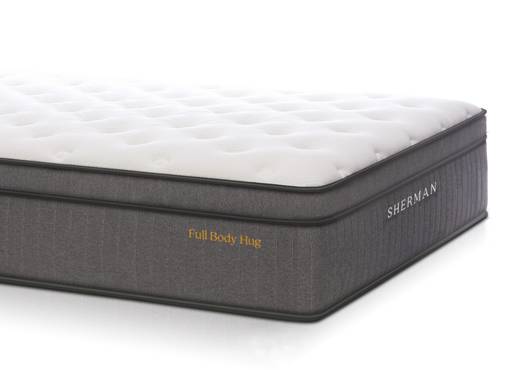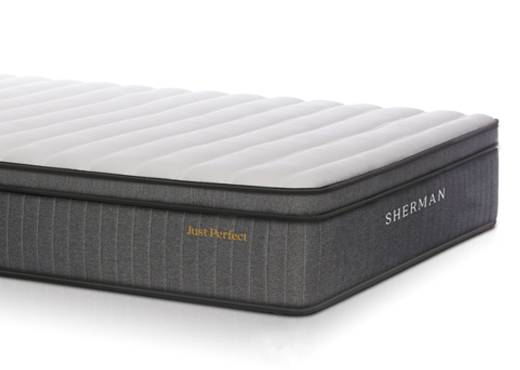Choosing the right pillow
When it comes to choosing a new mattress, most likely you will do a lot of research online or even visit some mattress stores and hopefully you’ll end up giving one of our luxury Sherman mattresses a try!
But what about your pillow?
How do you choose the right pillow to compliment your new mattress and give the right support to help you have a great night’s sleep?
Your pillow should support the natural curve of your neck and feel comfortable. A pillow that is too high can put your neck into a position that causes muscle strain on your back, neck, and shoulders. Choose a pillow that will keep the neck aligned with the chest and lower back.
Best pillow for side-sleepers
If you’re sleeping on a very firm mattress and your shoulder doesn’t dig into the mattress too much then the ideal pillow for you is one that is as thick as the distance between your ear and outside shoulder. Of course, if your shoulders are sinking into a softer mattress, then you may not have as much of a gap to fill. Our ‘Head Honcho’ pillow is a good one for side-sleepers!
Best pillow for back-sleepers
You’ll need a much lower pillow and as above, it really depends on how much the back of your shoulders is sinking into the mattress. The idea here is that you’re not trying to elevate your head, it’s more about having something low and cushioned to fill the gap behind your neck whilst you sleep. To check if a pillow is too high for sleeping on your back, make sure your chin is not tucked downwards towards your throat.
Best pillow for stomach-sleepers
If you sleep on your stomach, you may need a soft pillow or no pillow at all. Most stomach sleepers turn their head to the side and only need the comfort of a soft, low pillow. Ideally the pillow should be under your collarbone as well to avoid waking with a sore neck.
I like sleeping on two pillows, is that ok?
It can be tricky finding the perfect pillow so sometimes using two low pillows will fit the bill. Once again, you need to make sure that you’re not adding too much height beneath your head.
Should my shoulders be on the pillow when sleeping?
Pillows are to support your head and neck, not your shoulders. Placing your shoulders on a pillow lifts your entire upper body, leaving your head and neck unsupported.
What kind of pillow should I get?
There are lots of different fillings available in pillows.
Latex: A very good choice as long as you’re sure that the pillow is natural latex. Latex is long lasting, resistant to mould and bacteria and dust mites and has a firm level of cushioning which is good for supporting your head. If the pillow is natural latex it will be quite expensive, but worth the investment if it fits your needs.
Memory Foam (or visco elastic): Another excellent choice as these are very long-lasting. Memory foam provides pressure relief like no other foam can so these pillows are perfect for all types of sleepers and are available in any height and firmness. Memory foam is expensive but will outlast any other type of foam by many years.
Feather down: These can be very comfortable for back sleepers because you can adapt the shape of down-filled pillows a little more than with foam. So, your head can push into the pillow and most of the filling will be supporting your neck.
Polyester filling: Always the cheapest style of pillow that you can buy and available in many heights and firmnesses, they don’t tend to last very long. It’s difficult to wash the inner pillow and they generally go ‘lumpy’ when you do. For this reason, you shouldn’t sleep on a polyester filled pillow for more than a year, after that time the accumulation of dust mites may start to cause problems.
The perfect pillow for you is highly subjective and you may want to try a few different ones before you find the right one. But generally, a pillow that is firm enough to hold the head at a healthy angle, but soft enough to alleviate pressure points will help you to get a good night’s sleep and have you feeling better when you’re awake.
How often should I wash my pillow?
A lot more often than you think! Like every soft furnishing in your home, dust mites love to live in pillows and these can cause all sorts of problems from allergies to asthma. You should always use a pillowcase to protect your pillow and wash the pillowcase every week. A pillow that has a zipped, removable cover is a good idea because you can wash the cover every month. You’ll find most foam and latex pillows have this.
What’s the best pillow for avoiding dust-mites?
As above, the best way to avoid dust mites is to have removable covers and wash them frequently. Asthma and allergy sufferers may benefit from using two pillowcases and changing/ washing them more often to avoid a build up of dust mites.
With solid foam pillows, you can gently hand wash the foam and put it out in the sun to dry. This is an excellent way to remove dust-mites. Of course, you can’t do that with polyester filling or feather filled pillows.
It is an old wives tale that people who suffer from asthma or allergies shouldn’t use down pillows but recent studies show that the tightly woven encasing needed to contain feathers is more of an inhibitor to dust mites than the loosely woven covers that are commonly found on synthetic foam or latex pillows.
The perfect pillow for you is highly subjective and you may want to try a few different ones before you find the right one. But generally, a pillow that is firm enough to hold the head at a healthy angle, but soft enough to alleviate pressure points will help you to get a good night’s sleep and have you feeling better when you’re awake.




